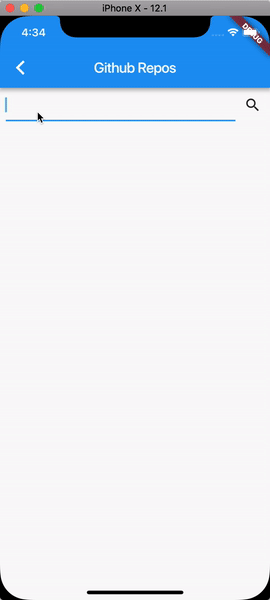GitHub Repos
In this example, we will use the 
ObservableFuture
with an Observer.
Define the observable state
The first step is to define the reactive (aka observable) state of your UI. This gives you a good grounding on what is to be expected eventually on the UI itself.
In this case, we want a simple UI where we accept the github-ID as input. We use that to fetch the user's repositories. This call will be made using the

List<Repository>. The GithubStore class so far looks like so:
import 'package:github/github.dart';
import 'package:mobx/mobx.dart';
part 'github_store.g.dart';
class GithubStore = _GithubStore with _$GithubStore;
abstract class _GithubStore with Store {
final GitHub client = GitHub();
List<Repository> repositories = [];
String user = '';
}
Notice that we are not making the repositories into an observable field.
Instead, we will make use of the ObservableFuture to track it.
Dealing with async
The call to fetch repositories is an async operation. We do want to track and
show the visual feedback while this network call is in progress. Such
async-operations are normally tracked with an ObservableFuture.
An
ObservableFutureis a wrapper around aFutureand gives you a way to react to thestatuschanges.
In our case, we will use one like below. The ObservableFuture is tracking the
results, which is a List<Repository>.
abstract class _GithubStore with Store {
// ...
// We are starting with an empty future to avoid a null check
ObservableFuture<List<Repository>> fetchReposFuture = emptyResponse;
bool get hasResults =>
fetchReposFuture != emptyResponse &&
fetchReposFuture.status == FutureStatus.fulfilled;
static ObservableFuture<List<Repository>> emptyResponse =
ObservableFuture.value([]);
// ...
}
A few things to note here:
- The
fetchReposFutureis marked as an@observable, because it will change its value when the network call is invoked. We start with anemptyResponseto avoid making null checks. - The
@computedfieldhasResultsis an easy way to know if there are results available. It is normally a good practice to create such computed-fields to simplify the logic.
Adding the actions
Now that we have our reactive state ready, we can focus on defining the actions that will mutate this state. We have two operations that will be invoked from the UI:
- Setting the github-ID
- Invoking the async operation to fetch the repos
Both of these have been incorporated in the _GithubStore class:
abstract class _GithubStore with Store {
// ...
Future<List<Repository>> fetchRepos() async {
repositories = [];
final future = client.repositories.listUserRepositories(user).toList();
fetchReposFuture = ObservableFuture(future);
return repositories = await future;
}
void setUser(String text) {
fetchReposFuture = emptyResponse;
user = text;
}
}
The interesting thing about fetchRepos() is that it is an async-action.
MobX is smart enough to wrap the mutations inside an action-construct. This
ensures there are no stray mutations once the async operation completes.
And with that we are ready with our observable state and actions. Let's get on with the Flutter UI.
Tackle the UI
The top-level widget is a StatefulWidget that holds the instance of the
GithubStore and assembles all of the other observer-Widgets.
class GithubExample extends StatefulWidget {
const GithubExample();
GithubExampleState createState() => GithubExampleState();
}
class GithubExampleState extends State<GithubExample> {
final GithubStore store = GithubStore();
Widget build(BuildContext context) => Scaffold(
appBar: AppBar(
title: const Text('Github Repos'),
),
body: Column(
children: <Widget>[
UserInput(store),
ShowError(store),
LoadingIndicator(store),
RepositoryListView(store)
],
));
}
Most of the widgets in the Column should be self-explanatory. The simplest of
these is the LoadingIndicator, a StatelessWidget, that tracks when the fetch
operation is in progress. The Observer is from the

fetchReposFuture
field, an ObservableFuture, to show the loading indicator when the status is
pending.
LoadingIndicator
class LoadingIndicator extends StatelessWidget {
const LoadingIndicator(this.store);
final GithubStore store;
Widget build(BuildContext context) => Observer(
builder: (_) => store.fetchReposFuture.status == FutureStatus.pending
? const LinearProgressIndicator()
: Container());
}
RepositoryListView
The list-view for repositories also shows the state for an empty list of repos.
If there is at least one repo, it will build the ListView and render the
repositories. Notice the use of the computed field hasResults, which
simplifies the overall logic of the component.
class RepositoryListView extends StatelessWidget {
const RepositoryListView(this.store);
final GithubStore store;
Widget build(BuildContext context) => Expanded(
child: Observer(
builder: (_) {
if (!store.hasResults) {
return Container();
}
if (store.repositories.isEmpty) {
return Row(
mainAxisAlignment: MainAxisAlignment.center,
children: <Widget>[
const Text('We could not find any repos for user: '),
Text(
store.user,
style: const TextStyle(fontWeight: FontWeight.bold),
),
],
);
}
return ListView.builder(
itemCount: store.repositories.length,
itemBuilder: (_, int index) {
final repo = store.repositories[index];
return ListTile(
title: Row(
children: <Widget>[
Text(
repo.name,
style: const TextStyle(fontWeight: FontWeight.bold),
),
Text(' (${repo.stargazersCount} ⭐️)'),
],
),
subtitle: Text(repo.description ?? ''),
);
});
},
),
);
}
In Action
Below you can see the example working for various use cases.
